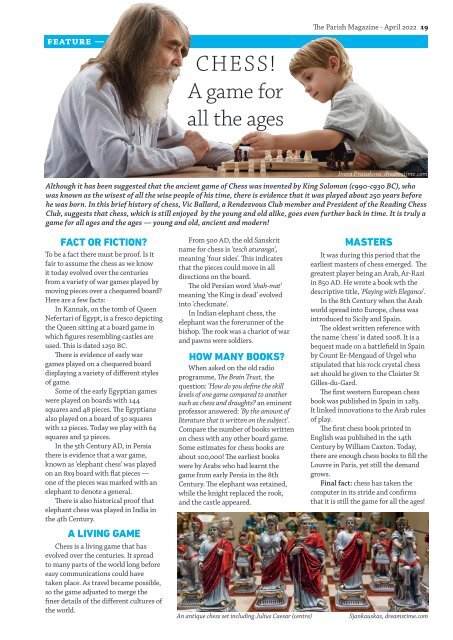The Parish Magazine April 2022
Serving the communities of Charvil, Sonning and Sonning Eye since 1869
Serving the communities of Charvil, Sonning and Sonning Eye since 1869
You also want an ePaper? Increase the reach of your titles
YUMPU automatically turns print PDFs into web optimized ePapers that Google loves.
feature — 1<br />
CHESS!<br />
A game for<br />
all the ages<br />
<strong>The</strong> <strong>Parish</strong> <strong>Magazine</strong> - <strong>April</strong> <strong>2022</strong> 19<br />
Inara Prusakova, dreamstime.com<br />
Although it has been suggested that the ancient game of Chess was invented by King Solomon (c990-c930 BC), who<br />
was known as the wisest of all the wise people of his time, there is evidence that it was played about 250 years before<br />
he was born. In this brief history of chess, Vic Ballard, a Rendezvous Club member and President of the Reading Chess<br />
Club, suggests that chess, which is still enjoyed by the young and old alike, goes even further back in time. It is truly a<br />
game for all ages and the ages — young and old, ancient and modern!<br />
FACT OR FICTION?<br />
To be a fact there must be proof. Is it<br />
fair to assume the chess as we know<br />
it today evolved over the centuries<br />
from a variety of war games played by<br />
moving pieces over a chequered board?<br />
Here are a few facts:<br />
In Kannak, on the tomb of Queen<br />
Nefertari of Egypt, is a fresco depicting<br />
the Queen sitting at a board game in<br />
which figures resembling castles are<br />
used. This is dated 1250 BC.<br />
<strong>The</strong>re is evidence of early war<br />
games played on a chequered board<br />
displaying a variety of different styles<br />
of game.<br />
Some of the early Egyptian games<br />
were played on boards with 144<br />
squares and 48 pieces. <strong>The</strong> Egyptians<br />
also played on a board of 30 squares<br />
with 12 pieces. Today we play with 64<br />
squares and 32 pieces.<br />
In the 5th Century AD, in Persia<br />
there is evidence that a war game,<br />
known as 'elephant chess' was played<br />
on an 8x9 board with flat pieces —<br />
one of the pieces was marked with an<br />
elephant to denote a general.<br />
<strong>The</strong>re is also historical proof that<br />
elephant chess was played in India in<br />
the 4th Century.<br />
A LIVING GAME<br />
Chess is a living game that has<br />
evolved over the centuries. It spread<br />
to many parts of the world long before<br />
easy communications could have<br />
taken place. As travel became possible,<br />
so the game adjusted to merge the<br />
finer details of the different cultures of<br />
the world.<br />
From 500 AD, the old Sanskrit<br />
name for chess is 'tesch aturanga',<br />
meaning 'four sides'. This indicates<br />
that the pieces could move in all<br />
directions on the board.<br />
<strong>The</strong> old Persian word 'shah-mat'<br />
meaning 'the King is dead' evolved<br />
into 'checkmate'.<br />
In Indian elephant chess, the<br />
elephant was the forerunner of the<br />
bishop. <strong>The</strong> rook was a chariot of war<br />
and pawns were soldiers.<br />
HOW MANY BOOKS?<br />
When asked on the old radio<br />
programme, <strong>The</strong> Brain Trust, the<br />
question: 'How do you define the skill<br />
levels of one game compared to another<br />
such as chess and draughts? an eminent<br />
professor answered: 'By the amount of<br />
literature that is written on the subject'.<br />
Compare the number of books written<br />
on chess with any other board game.<br />
Some estimates for chess books are<br />
about 100,000! <strong>The</strong> earliest books<br />
were by Arabs who had learnt the<br />
game from early Persia in the 8th<br />
Century. <strong>The</strong> elephant was retained,<br />
while the knight replaced the rook,<br />
and the castle appeared.<br />
An antique chess set including Julius Caesar (centre)<br />
MASTERS<br />
It was during this period that the<br />
earliest masters of chess emerged. <strong>The</strong><br />
greatest player being an Arab, Ar-Razi<br />
in 850 AD. He wrote a book wth the<br />
descriptive title, 'Playing with Elegance'.<br />
In the 8th Century when the Arab<br />
world spread into Europe, chess was<br />
introduced to Sicily and Spain.<br />
<strong>The</strong> oldest written reference with<br />
the name 'chess' is dated 1008. It is a<br />
bequest made on a battlefield in Spain<br />
by Count Er-Mengaud of Urgel who<br />
stipulated that his rock crystal chess<br />
set should be given to the Cloister St<br />
Gilles-du-Gard.<br />
<strong>The</strong> first western European chess<br />
book was published in Spain in 1283.<br />
It linked innovations to the Arab rules<br />
of play.<br />
<strong>The</strong> first chess book printed in<br />
English was published in the 14th<br />
Century by William Caxton. Today,<br />
there are enough chess books to fill the<br />
Louvre in Paris, yet still the demand<br />
grows.<br />
Final fact: chess has taken the<br />
computer in its stride and confirms<br />
that it is still the game for all the ages!<br />
Sjankauskas, dreamstime.com


















